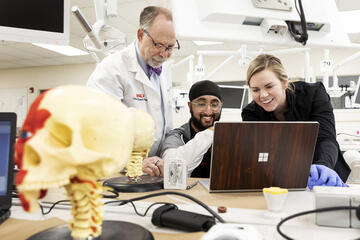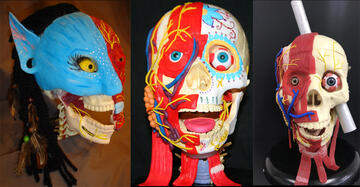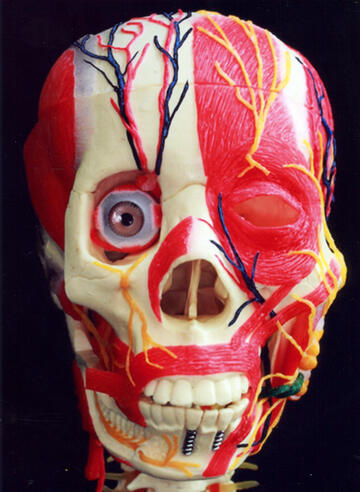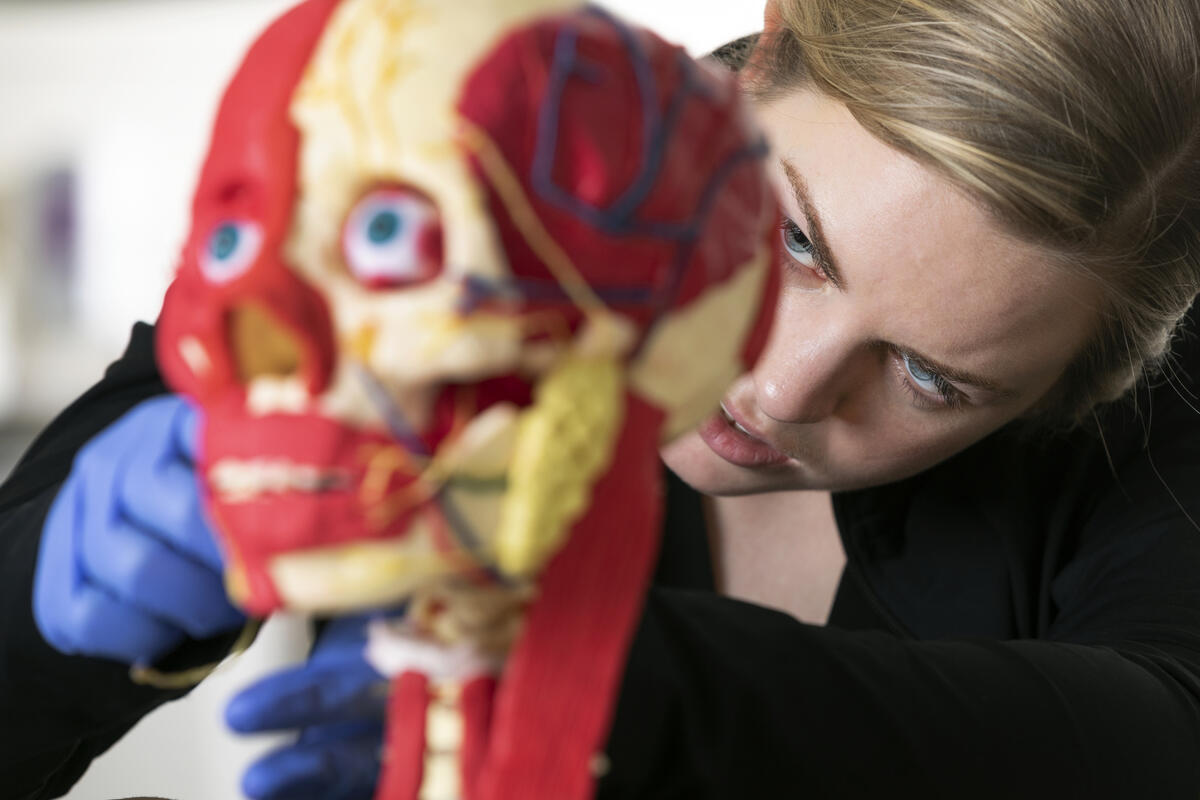Just your typical supply list for a semester: laptop, textbooks, skull, notebooks. Wait. Skull?
For second-year students in the UNLV School of Dental Medicine, a plastic skull is a requisite for the Clinically Oriented Anatomy course. Through seven weeks of hands-on modeling with colored dental wax and thread, the students construct, layer by layer, an anatomically correct skull.
While the course focus is science, its process is art. So much so that it caught the attention of an art museum in Santa Fe, New Mexico.
Building Up Knowledge
In decades past, the default method for teaching the science of anatomy was through dissection. “It’s a wonderful way to learn, but there are numerous inherent problems with it,” said professor Lawrence Zoller, one of the course’s instructors. “To use cadavers, you need a lot of space and specially ventilated rooms. A cadaver’s jaw is stiff, so it’s difficult to move into a position where dental students can clearly see the physical landmarks of where to give injections.”
Such drawbacks have prompted institutions to adopt alternatives to traditional cadaveric anatomy. Students in the UNLV School of Medicine, for example, “dissect” the human body through virtual anatomy tables.

The dental school’s alternative, however, turns the dissection process around: building up rather than removing. “With dissection, you take materials off sequentially until you get down to the bone,” Zoller explained. “This is the opposite process. You start with a blank skull. As you place structures and layer them, you learn their relationship to one another, which is critical in dentistry.”
The classroom is part art studio, part makerspace during the seven two-hour modeling sessions led by Zoller and biomedical sciences professor Joshua Polanksi. Various types of colored dental wax are piled high in the front of the room. Red, blue, and yellow threads — for arteries, veins, and nerves — weave their way through the workstations. With hacksaws and coping saws, the students carve away parts of the skull to rebuild the structures in wax. They delicately align ducts, glands, and muscles into their proper orientation with precision dental tools.
“Wax is a very forgiving material,” Zoller said. “If a student gets the placement of a structure wrong, they’re able to take off the wax and correct it.”
The emphasis remains on learning anatomy at a deep level but 20 percent of the grade goes to the creativity. “It’s based on what the student wants to do,” he said. “Some students are very practice-oriented; they add on extra muscles and other structures. That’s great.

“Other students get astoundingly inventive,” he continued. “One student did half the skull as a Dia de los Muertos figure. We’ve had a Klingon from Star Trek and a blue Na’vi from the movie Avatar. One student even modeled Phineas Gage, the famous medical patient who had a railroad spike driven through his skull.”
Zoller had never really connected his students’ work with anything beyond the dental school. Many of the students leave behind their completed skulls, which Zoller keeps as examples for subsequent classes. But when preparing for a January trip to Santa Fe, Zoller stumbled across a listing for the Museum of Encaustic Art — a museum devoted exclusively to wax art “from ancient beeswax to the modern crayon,” as its tagline reads.
An Artistic Turn
The Greeks originated the art form and gave it its name (enkaustikos, meaning “to heat or burn in”), from the process of heating and fusing beeswax and crystallized tree sap. The museum’s collection includes wax works from paintings to collages to sculptures. “We want to represent all different forms of encaustic art in the museum,” said founder and curator Douglas Mehrens. So when Zoller called for a tour and described the skull modeling course, Mehrens asked the professor to bring an example.

Zoller culled through the orphaned skulls and presented Mehrens with the one he thought best represented the course. “It was even more amazing than I expected,” Mehrens said. “It’s like nothing we have in the museum. It’s not on clay or wood but an entirely novel material. And the fact that those skulls are the representation of what the students are learning is wonderful.”
Mehrens asked if he could keep the skull for the museum’s collection — with the creator’s permission, of course. That wasn’t so easy; the skull wasn’t labeled. Zoller had to scroll through 320 student PowerPoint presentations – twice – from four years of students to pair the skull with its owner.
When Erik Foisy, '12 BS Biology, ’14 DMD, heard the voicemail message from Zoller, he recognized his former professor’s distinctive voice right away. “When I left the skull behind, I hoped it would help another student out,” said Foisy, now in an endodontic residency in Richmond, Virginia. “I’d never considered it being recognized as art. Not a lot of people can say they produced a piece of art that is in a museum.”
Not a lot of dental programs, either. “I’m used to looking at these skulls and seeing the anatomy,” Zoller said. “But the first thing Douglas said was, ‘This is art.’ He is right. I hope that visitors to the museum will recognize that when they look at the skull and appreciate the amount of work that goes into it. If they do, then that is a wonderful reflection on this university."



